Seed starting mix can be expensive to buy, so I came up with my own homemade recipe. This is the best medium to use, and it’s also very easy to make.
In this post, I’ll tell you all you need to know about seed starting soil. Including choosing which type to use, and what properties to look for.
I will also show you exactly how to make your own DIY seed starter soil mix from scratch with only a couple of ingredients, and give you tips for properly storing the leftovers.
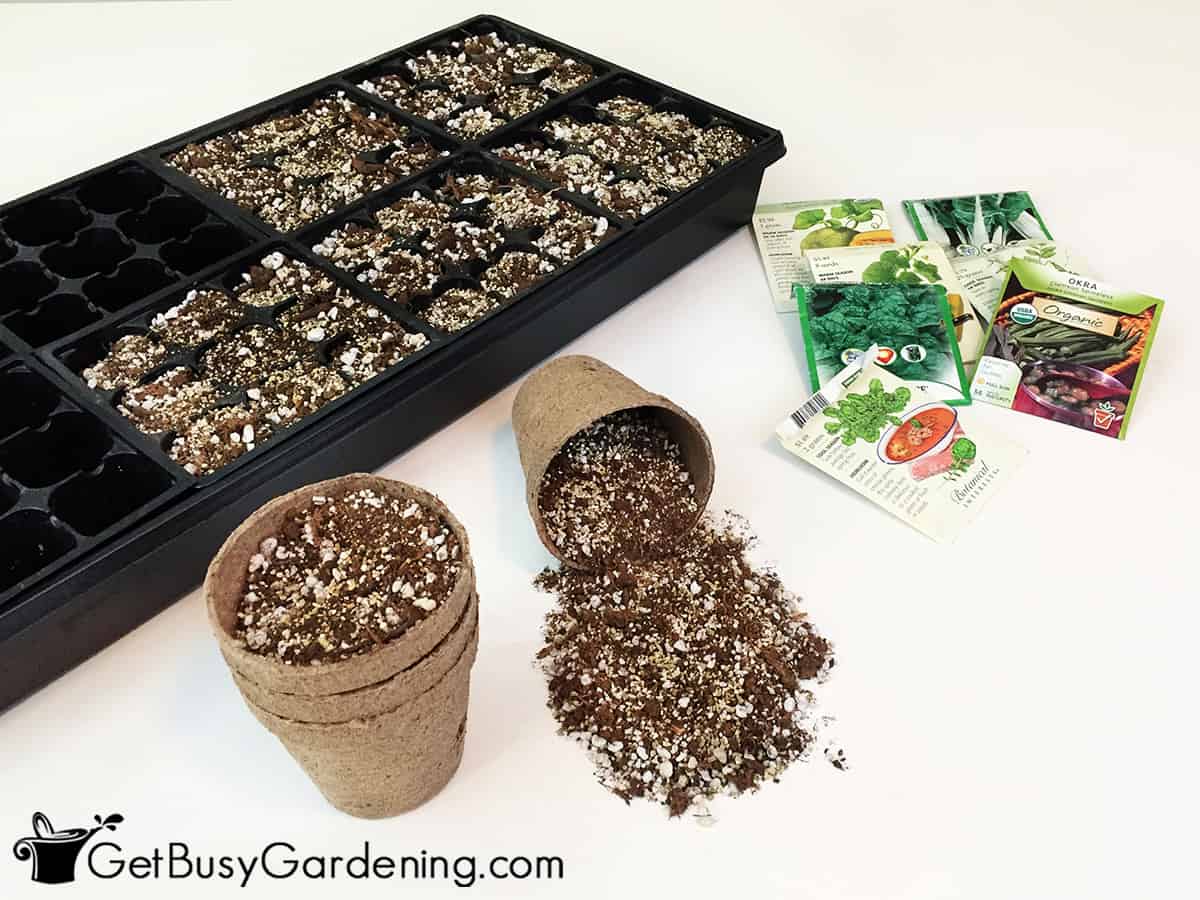
The Best Seed Starting Mix
The best seed starting medium is a soilless mix that’s fast draining, lightweight, aerated, and also holds moisture. You should always either buy a quality brand or make your own using my recipe below.
Trust me, the type of soil you use really does matter – and it can be the difference between seed starting success or epic failure! So read the package to find something with the following properties:
- Well-draining – If the soil holds too much moisture, or becomes overly wet or soggy, it can cause the seeds to rot, prevent germination, or suffocate delicate roots.
- Light & airy – Seed starting mix should be lightweight and fluffy, so that plenty of air can reach the developing roots. Heavy soils tend to become compact in containers, which will inhibit germination.
- Porous mix – A porous medium is loose and aerated. This allows water to drain through it quickly without retaining too much, and also prevents compaction.
- Moisture retentive – It’s extremely important that the soil stays evenly moist for both germination and healthy seedling growth. The mix should retain water to prevent it from drying out too quickly.
- Alkaline – The soil should be alkaline for starting most type of seeds, ideally between 5-8 on a pH probe gauge.
Related Post: Seed Starting Peat Pellets Vs. Soil: Which Should You Use And Why?
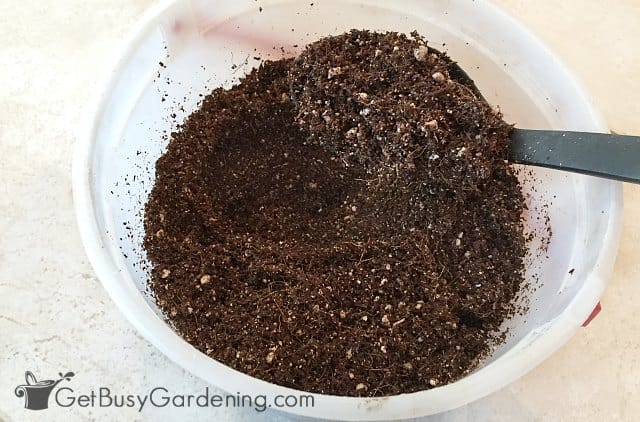
How To Make Seed Starting Mix
While there are many different options for commercial seed starting soil on the market these days, it’s usually cheaper to make your own.
Plus it’s quick and easy, and you have full control of what goes into it, so you can ensure it contains quality ingredients. Here’s my recipe:
DIY Seed Starting Mix Recipe
- 8 parts coco coir or peat moss (pre-moistened)
- 1 part vermiculite
- 1 part perlite or pumice
- 1 tablespoon garden lime per gallon (if you use peat moss)
I like to use a 1-cup measure as my “part” because it makes the perfect amount to fill up a commercial seed starting tray. You can use anything you want though, as long as it’s the same thing for each “part”.
Related Post: How To Clean & Disinfect Your Seed Starting Trays
Ingredients
- Coco coir or peat moss – These are interchangeable, so you could use either one as your base ingredient. They both work equally well to improve water retention, aeration, and drainage.
- Vermiculite – This naturally occurring mineral helps the seed starting mix retain moisture, while also preventing it from staying too wet.
- Perlite or pumice – You can use either one of these, they both add drainage to the medium, to keep it from holding too much water or becoming compacted.
- Garden lime – Peat moss is slightly acidic, so you should add lime to neutralize it. You don’t need to use this with coco coir.
Related Post: How To Make Newspaper Seed Starting Pots

Tips For Mixing Your Homemade Seed Starting Soil
Once you gather your ingredients, making your own seed starting mix is very easy. You could whip up a large batch ahead of time, or just a small one when you need it.
Simply dump all of the ingredients into a bowl or potting tray. Then use a hand trowel to stir them together until they’re well blended. You can use it right away or store it for later.
Related Post: How To Grow Seeds: The Ultimate Guide
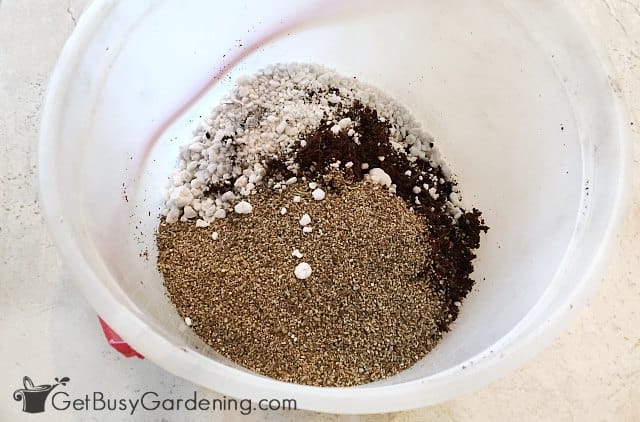
Storing Your Leftover DIY Seed Starter Mix
Whether you make your own soil for seed starting, or choose to buy a commercial brand, it’s important to properly store the leftovers to prevent bugs and contamination.
I like to put mine in a plastic bucket with an airtight lid, which works great to keep pathogens out. Store the container in a cool, dry location until you’re ready to use it.
Making your own DIY seed starting mix is easy and economical. Use it right away, or save it for later. You can even use my homemade recipe for repotting your seedlings.
Looking for even more help with growing your own seeds? Then you should enroll in my Seed Starting Course. This fun, in-depth self-paced online course has everything you need to know. Register and get started today!
Otherwise, if you just need a refresher, or want a quick-start guide, my Starting Seeds Indoors eBook is for you!
More Seed Starting Tips
- Seed Starting Supplies & Equipment
- How To Figure Out When To Start Seeds Indoors
- Tips For Starting Seeds Indoors
- How To Test The Viability Of Old Seeds With An Easy Germination Test
- When To Put Seedlings Under Grow Lights & How Much Do They Need
More DIY Potting Soil Recipes
- How To Make Your Own Succulent Soil
- How To Make Your Own Gritty Potting Mix
- How To Make Potting Soil For Indoor Plants
- 7 Easy DIY Potting Soil Recipes To Mix Your Own
Share your favorite recipe for seed starting mix in the comments section below.
Printable Instructions
Seed Starting Mix Recipe & Instructions

This 3 ingredient seed starting mix recipe is easy to make, inexpensive, and the best soil for germination and seedling health. Follow these step-by-step instructions for how to make your own from scratch.
Materials
- 8 parts coco coir or peat moss (pre-moistened)
- 1 part vermiculite
- 1 part perlite or pumice
- 1 tablespoon garden lime per gallon (if you use peat moss)
Tools
- Measuring container
- Trowel or large spoon
- Mixing container
- Seed starting trays
Instructions
- Pour the coco coir or peat moss, vermiculite, perlite or pumice, and garden lime (if you use peat moss) into a bucket or bowl.
- Mix the ingredients until they are well blended.
- Once mixed together, you can fill your seedling trays and start planting right away.
- Otherwise, store it in a plastic bucket with a tight fitting lid.
Notes
- You can use anything you want for your "part", as long as you use the same measure for each ingredient.
- For example: if you use a 1 cup measure as your part, then this recipe would convert to 8 cups coir, 1 cup vermiculite, and 1 cup perlite.
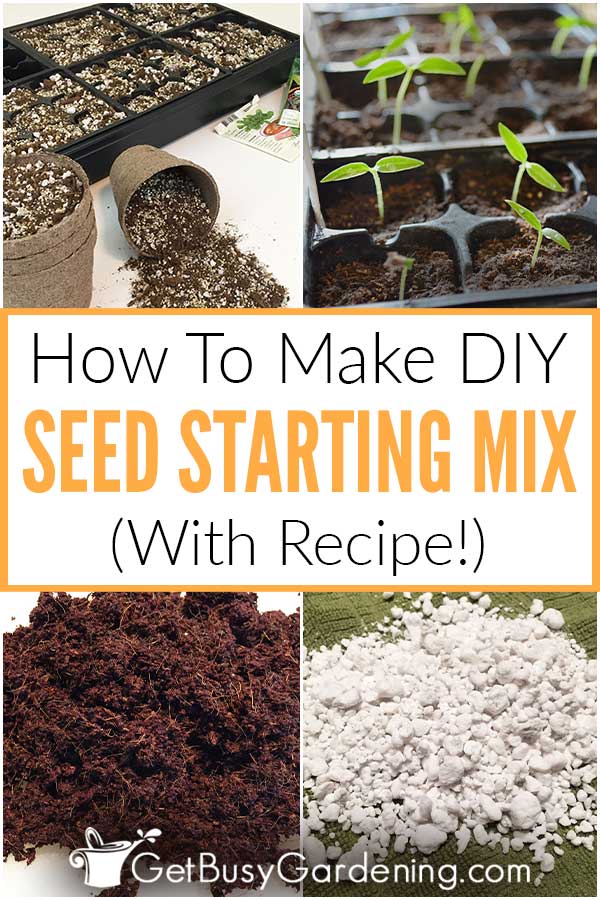
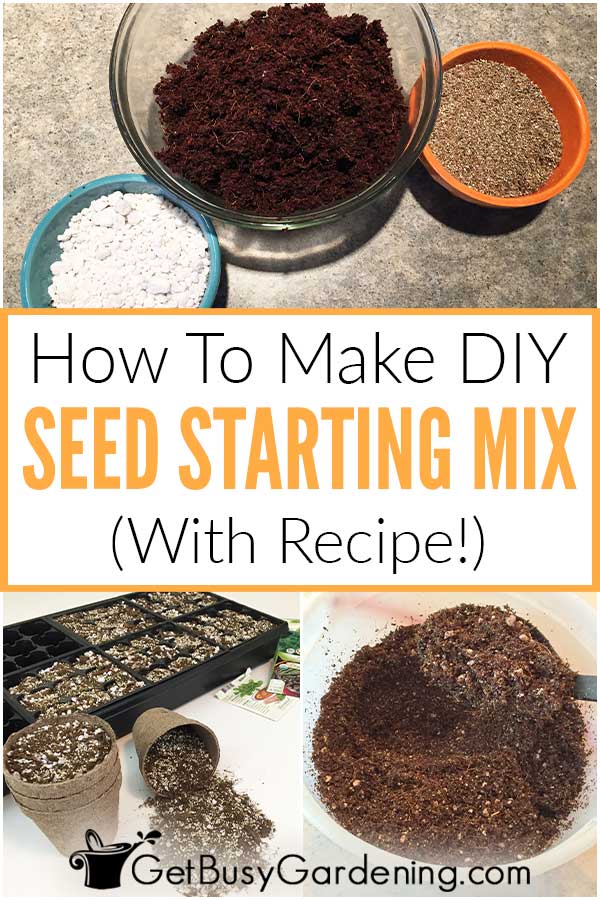
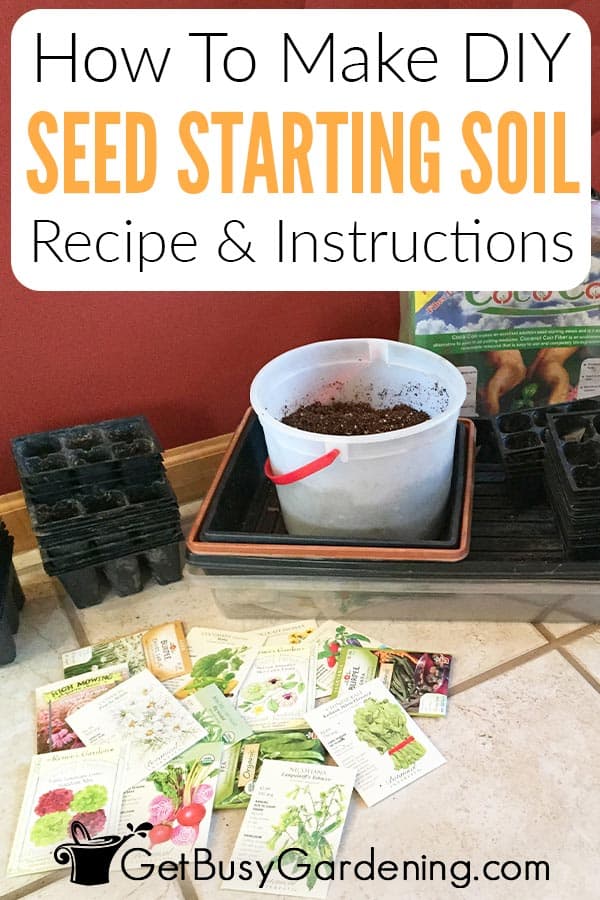
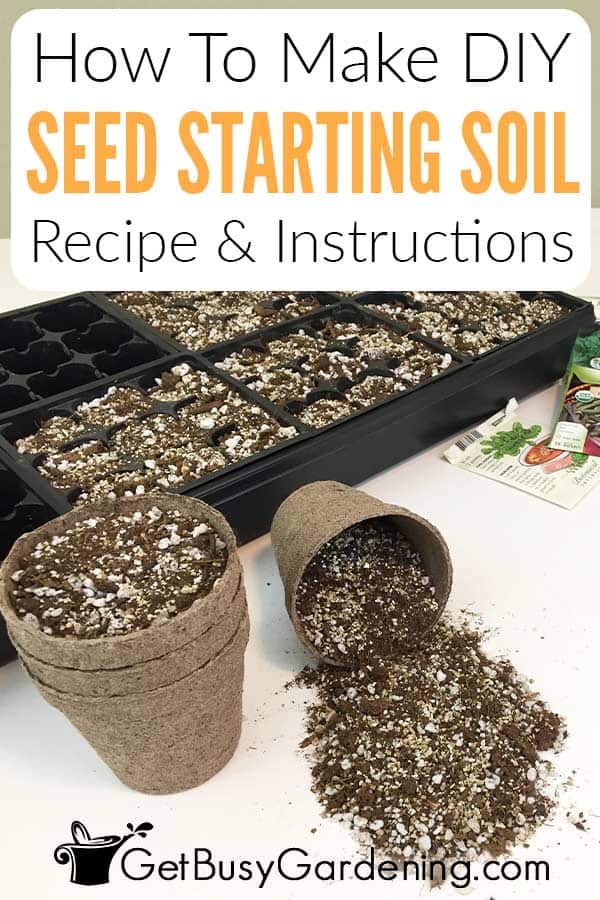
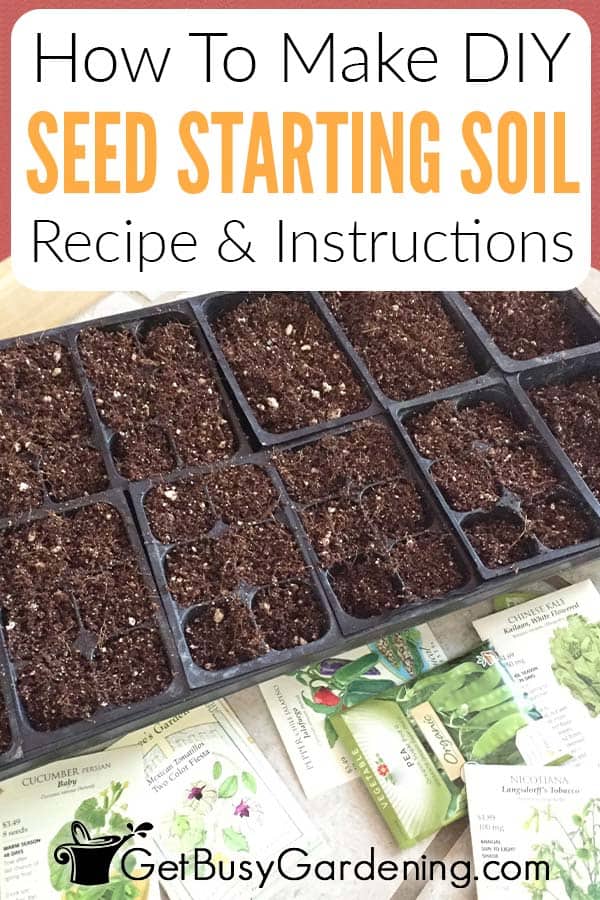
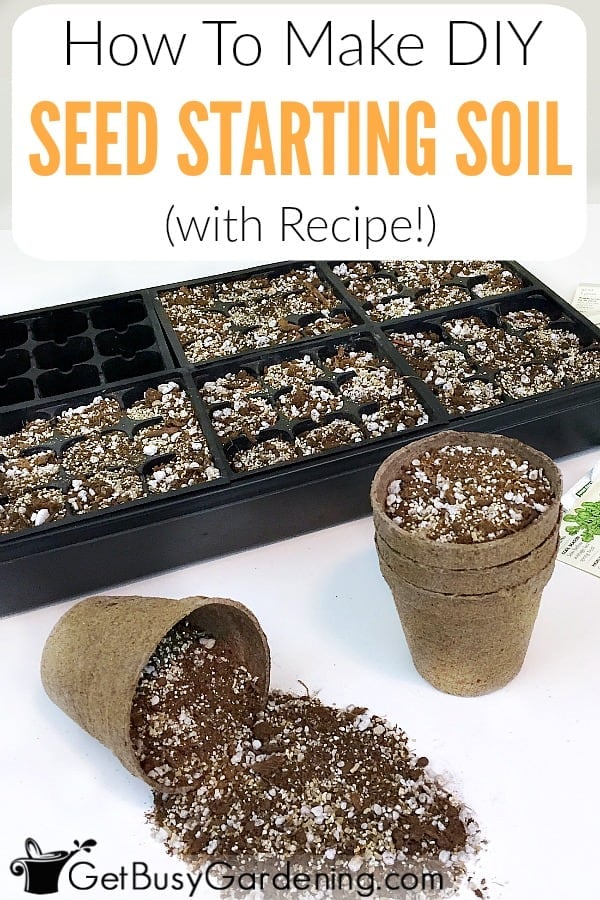

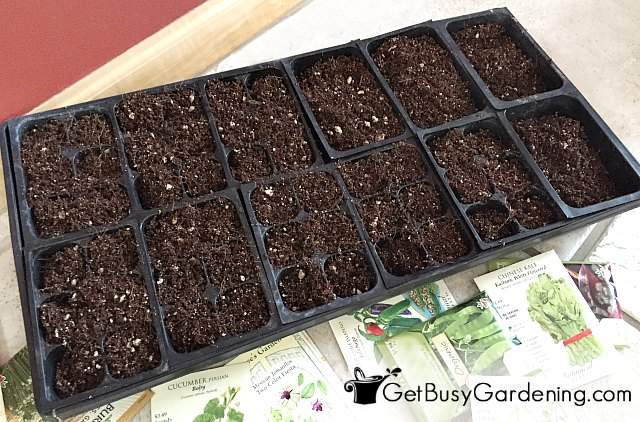


Yessenia Caballero says
Hi! Im using peat moss and was wondering how much garden lime to use for the 8part of peat moss?
Your recipe says 1/4 tsp per gallon. I’m not nearly at 1 gallon so was wondering if you could recommend a ratio of peat moss to garden lime? Thank you!!
Amy Andrychowicz says
Actually, you just pointed out an error in my recipe! It should be 1 tablespoon of garden lime per gallon of peat moss. I just made that correction.
But it’s hard to answer your question without knowing how big your “part” is. There are 16 cups in a gallon, and 3 teaspoons in a tablespoon, so you may need to get out the calculator, LOL. 🙂
donna j shorey says
Hi I like your seed starting mix recipe you did not mention if this mix would work for starting cactus seeds ? or do you have a different recipe for dessert plants?
Amy Andrychowicz says
Awesome to hear that you like my recipe. 🙂 Yes, I do have a different mix to use for dessert plants here… How To Make Your Own Succulent Soil (With Recipe!) Although, depending on the type of seeds you want to grow, the seed starting mix might be a better choice, since it will keep them moist, which may be better for germination.
April says
I live in central texas and have s fungus gnat problem no matter what I do. I make all my own growing mixes and still had the problem. Then I read on the Rustic Gardener site that if I wet my seedling mixture with boiling water and let it cool all the larva or eggs in the coir or peat would be killed. This wasn’t difficult I just mixed and waited a couple hours then planted. Thanks for your seedling recipe it grew great little seedlings for me–both garden and flower types
Amy Andrychowicz says
You’re welcome! Glad to hear my seedling soil recipe works so well for you. 🙂
Robin says
Yaaay, we make the same mix!
I have always been in love with Cocofibre (Coir), so glad to hear you recommend it!
Amy Andrychowicz says
Awesome! Yes, I love using the coco coir, it’s a wonderful material to work with.
Mina says
Amy we have the same handwriting style
Amy Andrychowicz says
Haha, how funny! 🙂
Sam Smith says
I love DIY projects, thank you for this.
Amy Andrychowicz says
You’re welcome! Hope your seeds will grow great in your DIY seed starting mix. 🙂
Rosemarie says
Just wanted to check, but after the seeds have sprouted and you transplant them into a larger container, you are recommending that you use the same seed starting mixture? Do you have to add some plant food to the mixture?
Amy Andrychowicz says
Yes, I use this same seed starting mix when I put up my seedlings. Those tiny seedling roots need a light and porous mix so they can easily grow (regular potting soil is too heavy for seedlings). I don’t add plant food to the soil at this point, I feed my seedlings with liquid fertilizer until they get transplanted into the garden or their final summer containers. Here’s more info about growing seeds indoors, including details about fertilizing seedlings.
Manjari says
Can this be used in raised beds as well ?
Amy Andrychowicz says
No, you don’t need to use this in your raised beds, this seed starting mix is just for starting seeds in containers.
Garth says
I have heard that used coffee grounds are good for soil also keeps ? away. Is this true?
Amy Andrychowicz says
Coffee grounds are good for the soil out in the garden, and to add to your compost bin… but I would not use it in a seed starting mix (or any other indoor potting mix). Coffee grounds mold really quickly, and you don’t want to encourage mold growth in your seed trays.
Lauren says
I’m having mold problems on the top of the soil. Any suggestions for something I can spray on top?
Amy Andrychowicz says
Mold growth on top of the soil is caused by improper ventilation of your seedling trays, or too much moisture. I vent my seedling trays as soon as most of the seedlings have sprouted, and then remove the lids shortly after. I never spray anything on my seedlings, giving them proper ventilation always does the trick. Here’s a post I wrote about mold on seedlings, and here are even more tips that might help you… Tips For Starting Seeds Indoors
Good luck, and I hope this will work for you!
Arielle says
sorry, i didn’t mean jiffy cells – they’re little mesh cylinders filled with potting soil. Again, they’re old and not labeled, they’ve been stored in a damp & dirty shed – is it advisable to use them?
Amy Andrychowicz says
Oh, I just saw this second comment. No, I would not use them. Just toss the dirt into your compost bin and get some fresh ones. 🙂
Arielle says
I have peat moss blocks and jiffy cells from years ago sitting in the shed. They’re not sterile by any means, but I didn’t see any reference to sterility. Can I use this old stuff?
Amy Andrychowicz says
When you say their not sterile, what do you mean? If they are still in the box, then they should be fine. But if they peat pellets/blocks already expanded or sitting in a really dirty location, then I would buy new ones.
Melissa says
Perfect. I have two of three ingredients for your seed starting mix so I just need to pick up some perlite. One question: are the ratios by volume or by weight?
Amy Andrychowicz says
By volume. Sometimes I even use a trowel or scoop to measure mine, nothing fancy. 🙂
Melissa says
Got it. Thanks!
Brandon Coppin says
This is great. It really does make a difference if you start seeds in the wrong kind of soil! I’ve used my own mix for both seed starting and container gardening for years and it works great. The vermiculite and perlite are especially helpful in maintaining healthy root systems!
cindy pearson says
Do you recommend this seed starting soil recipe for winter sowing? I’m so excited to try this for the first time! Love your posts.
Amy Andrychowicz says
Yes, you could use it for winter sowing too. Thank you!
Amy
Karyn says
Great DIY information. I custom mix all the growing medium that I use at my nursery. It’s the only way to really know what you’re planting with…. Bonus- it’s typically less expensive.
Amy Andrychowicz says
That’s great! Thanks for sharing your experience with making your own seed starting mix, and for a nursery too! Wow!
Amy